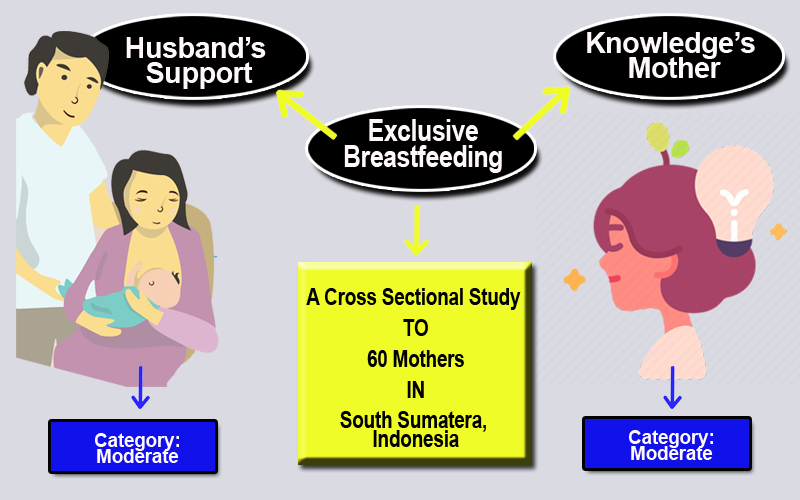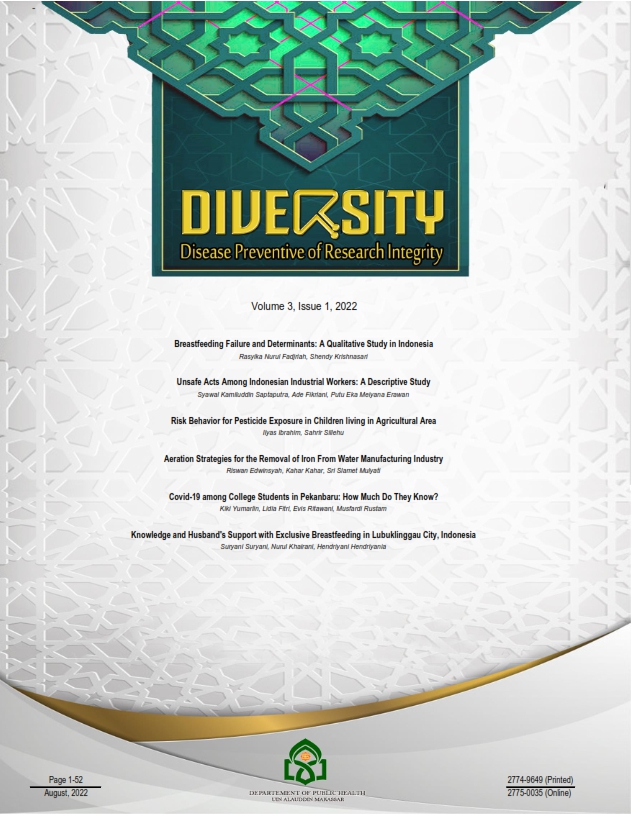Knowledge and Husband's Support with Exclusive Breastfeeding in Lubuklinggau City, Indonesia
Abstract
The provision of breastmilk for newborns is one of the efforts to prevent death and malnutrition in infants and toddlers. This study aimed to determine the relationship of the husband's knowledge and support with breastfeeding in Lubuklinggau City. This type of research was an analytical survey research with a cross-sectional design. The sampling technique used was random sampling to obtain a sample of 60 mothers. Data collection used primary data in the form of a questionnaire designed to test the mother's knowledge and husband's support. The data analysis technique was univariate and bivariate analysis with Chi-Square statistical test. The results showed that from 60 mothers, there were 22 mothers (36.7%) who had good knowledge, 34 mothers (56.7%) who supported their husbands well, and 32 mothers (53.3%) who exclusively breastfed their babies. This study found a significant relationship between husband's knowledge and support with exclusive breastfeeding in Lubuklinggau City with a moderate category. This provides information that to increase the mother's role in breastfeeding, and it needs to be supported by adequate knowledge about the benefits of breastfeeding for babies and family support, especially the husband as the closest person to the mother. This study recommends the importance of promoting exclusive breastfeeding for infants from various media and increasing the activity of posyandu cadres in providing information about exclusive breastfeeding.

Downloads
References
Adelodun, B., Ajibade, F. O., Ighalo, J. O., Odey, G., Ibrahim, R. G., Kareem, K. Y., & Choi, K. S. (2021). Assessment of socioeconomic inequality based on virus-contaminated water usage in developing countries: a review. Environmental Research, 192, 110309. https://doi.org/10.1016/j.envres.2020.110309
Aryanti, Z. (2017). Kelekatan dalam perkembangan anak. Tarbawiyah: Jurnal Ilmiah Pendidikan, 12(02), 245-258. https://e-journal.metrouniv.ac.id/index.php/tarbawiyah/article/view/479
Atabik, A. (2014). Faktor Ibu Yang Berhubungan Dengan Praktik Pemberian Asi Ekklusif di Wilayah Kerja Puskesmas Pamotan. Unnes Journal of Public Health, 3(1). https://journal.unnes.ac.id/sju/index.php/ujph/article/view/3534
Binns, C., Lee, M., & Low, W. Y. (2016). The long-term public health benefits of breastfeeding. Asia Pacific Journal of Public Health, 28(1), 7-14. https://doi.org/10.1177%2F1010539515624964
Bion, V., Lockett, G. A., Soto‐Ramírez, N., Zhang, H., Venter, C., Karmaus, W., & Arshad, S. H. (2016). Evaluating the efficacy of breastfeeding guidelines on long‐term outcomes for allergic disease. Allergy, 71(5), 661-670. https://doi.org/10.1111/all.12833
Datta, J., Graham, B., & Wellings, K. (2012). The role of fathers in breastfeeding: Decision-making and support. British journal of midwifery, 20(3), 159-167. https://doi.org/10.12968/bjom.2012.20.3.159
Davis, E. P., Stout, S. A., Molet, J., Vegetabile, B., Glynn, L. M., Sandman, C. A., & Baram, T. Z. (2017). Exposure to unpredictable maternal sensory signals influences cognitive development across species. Proceedings of the National Academy of Sciences, 114(39), 10390-10395. https://doi.org/10.1073/pnas.1703444114
Destyana, R. M., Angkasa, D., & Nuzrina, R. (2018). Hubungan peran keluarga dan pengetahuan ibu terhadap pemberian ASI di Desa Tanah Merah Kabupaten Tangerang. Indonesian Journal of Human Nutrition, 5(1), 41-50. https://doi.org/10.21776/ub.ijhn.2018.005.01.5
Dinas Kesehatan Kota Lubuklinggau (2018). Profil Puskesmas Perumnas. Sumatera Selatan
Dinas Kesehatan Provinsi Sumatera Selatan. (2018). Profil Kesehatan Provinsi Sumatera Selatan Tahun 2017. http://ppid-dinkes.sumselprov.go.id/download/95
Gebrekidan, K., Fooladi, E., Plummer, V., & Hall, H. (2020). Enablers and barriers of exclusive breastfeeding among employed women in low and lower middle-income countries. Sexual & Reproductive Healthcare, 25, 100514. https://doi.org/10.1016/j.srhc.2020.100514
Gedefaw, M., & Berhe, R. (2015). Determinates of childhood pneumonia and diarrhea with special emphasis to exclusive breastfeeding in north Achefer district, northwest Ethiopia: a case control study. Open Journal of Epidemiology, 5(02), 107. https://doi.org/10.4236/ojepi.2015.52014
Gibbs, B. G., & Forste, R. (2014). Breastfeeding, parenting, and early cognitive development. The Journal of Pediatrics, 164(3), 487-493. https://doi.org/10.1016/j.jpeds.2013.10.015
Hanieh, S., Ha, T. T., Simpson, J. A., Thuy, T. T., Khuong, N. C., Thoang, D. D., & Biggs, B. A. (2015). Exclusive breast feeding in early infancy reduces the risk of inpatient admission for diarrhea and suspected pneumonia in rural Vietnam: a prospective cohort study. BMC Public Health, 15(1), 1-10. https://doi.org/10.1186/s12889-015-2431-9
Hawley, N. L., Rosen, R. K., Strait, E. A., Raffucci, G., Holmdahl, I., Freeman, J. R., & McGarvey, S. T. (2015). Mothers’ attitudes and beliefs about infant feeding highlight barriers to exclusive breastfeeding in American Samoa. Women and Birth, 28(3), e80-e86. https://doi.org/10.1016/j.wombi.2015.04.002
Jama, A., Gebreyesus, H., Wubayehu, T., Gebregyorgis, T., Teweldemedhin, M., Berhe, T., & Berhe, N. (2020). Exclusive breastfeeding for the first six months of life and its associated factors among children age 6-24 months in Burao district, Somaliland. International breastfeeding journal, 15(1), 1-8. https://doi.org/10.1186/s13006-020-0252-7
Kelishadi, R., & Farajian, S. (2014). The protective effects of breastfeeding on chronic non-communicable diseases in adulthood: A review of evidence. Advanced biomedical research, 3. https://doi.org/10.4103%2F2277-9175.124629
Kementerian Kesehatan RI. (2019). Profil Kesehatan Indonesia Tahun 2018. https://pusdatin.kemkes.go.id/article/view/19070500001/profil-kesehatan-indonesia-2018.html
Kusumayanti, N., & Nindya, T. S. (2017). Hubungan dukungan suami dengan pemberian asi eksklusif di daerah perdesaan. Media Gizi Indonesia, 12(2), 98-106. https://doi.org/10.20473/mgi.v12i2.98-106
Lestari, R. R. (2018). Faktor-Faktor yang Berhubungan dengan Pemberian ASI Ekslusif pada Ibu. Jurnal obsesi: Jurnal Pendidikan anak usia dini, 2(1), 131-136. https://doi.org/10.31004/obsesi.v2i1.17
Marques, R. F., Taddei, J. A., Lopez, F. A., & Braga, J. A. (2014). Breastfeeding exclusively and iron deficiency anemia during the first 6 months of age. Revista da Associação Médica Brasileira, 60, 18-22. https://doi.org/10.1590/1806-9282.60.01.006
Mose, A., Dheresa, M., Mengistie, B., Wassihun, B., & Abebe, H. (2021). Colostrum avoidance practice and associated factors among mothers of children aged less than six months in Bure District, Amhara Region, North West, Ethiopia: A community-based cross-sectional study. PloS one, 16(1), e0245233. https://doi.org/10.1371/journal.pone.0245233
Motsa, L. F., Ibisomi, L., & Odimegwu, C. (2016). The influence of infant feeding practices on infant mortality in Southern Africa. Maternal and child health journal, 20(10), 2130-2141.
https://doi.org/10.1007/s10995-016-2033-x
Nurleli, N., Purba, J. M., & Sembiring, R. (2018). Hubungan Pengetahuan Dan Sikap Ibu Dengan Tindakan Pemberian Asi Eksklusif Di Puskesmas Rambung Kecamatan Binjai Selatan Kota Binjai Tahun 2017. Jurnal Riset Hesti Medan Akper Kesdam I/BB Medan, 3(1), 1-9. https://doi.org/10.34008/jurhesti.v3i1.16
Oktalina, O., Muniroh, L., & Adiningsih, S. (2015). Hubungan dukungan suami dan dukungan keluarga dengan pemberian asi eksklusif pada ibu anggota kelompok pendukung asi (KP-ASI). Media Gizi Indonesia, 10(1), 64-70. https://ojs2.e-journal.unair.ac.id/MGI/article/view/3128
Pitaloka, D. A., Abrory, R., & Pramita, A. D. (2018). Hubungan antara pengetahuan dan pendidikan ibu dengan pemberian ASI eksklusif di Desa Kedungrejo Kecamatan Waru Kabupaten Sidoarjo. Amerta Nutrition, 2(3), 265-270. http://dx.doi.org/10.20473/amnt.v2i3.2018.265-270
Quigley, M. A., Carson, C., Sacker, A., & Kelly, Y. (2016). Exclusive breastfeeding duration and infant infection. European journal of clinical nutrition, 70(12), 1420-1427. https://doi.org/10.1038%2Fejcn.2016.135
Quthb, S. (2010). Tafsir fi zhilalil-Quran di Bawah Naungan Al-Quran Jilid 4 : Fi Zhilalil Quran. Jakarta: Gema Insani.
Raman, S., Srinivasan, K., Kurpad, A., Dwarkanath, P., Ritchie, J., & Worth, H. (2014). ‘My Mother… My Sisters… and My Friends’: Sources of maternal support in the perinatal period in urban India. Midwifery, 30(1), 130-137. https://doi.org/10.1016/j.midw.2013.03.003
Savarino, G., Corsello, A., & Corsello, G. (2021). Macronutrient balance and micronutrient amounts through growth and development. Italian Journal of Pediatrics, 47(1), 1-14. https://doi.org/10.1186/s13052-021-01061-0
Scherbaum, V., & Srour, M. L. (2016). The role of breastfeeding in the prevention of childhood malnutrition. Hidden Hunger, 115, 82-97. https://doi.org/10.1159/000442075
Seid, A. M., Yesuf, M. E., & Koye, D. N. (2013). Prevalence of Exclusive Breastfeeding Practices and associated factors among mothers in Bahir Dar city, Northwest Ethiopia: a community based cross-sectional study. International breastfeeding journal, 8(1), 1-8. https://doi.org/10.1186/1746-4358-8-14
Shihab, M. Q. (2002). Tafsir al-misbah. Jakarta: Lentera Hati, 2. Mizan Pustaka.
Sitorus, S. B. M. (2016). Pengaruh Dukungan Keluarga dan Faktor Sosial Budaya Terhadap Pemberian ASI Eksklusif pada Bayi 0–6 Bulan di Wilayah Kerja Puskesmas Sukaraya Kecamatan Pancurbatu Kabupaten Deli Serdang [Universitas Sumatera Utara]. https://repositori.usu.ac.id/handle/123456789/16672
Tewabe, T., Mandesh, A., Gualu, T., Alem, G., Mekuria, G., & Zeleke, H. (2016). Exclusive breastfeeding practice and associated factors among mothers in Motta town, East Gojjam zone, Amhara Regional State, Ethiopia, 2015: a cross-sectional study. International breastfeeding journal, 12(1), 1-7. https://doi.org/10.1186/s13006-017-0103-3
Thepha, T., Marais, D., Bell, J., & Muangpin, S. (2018). Perceptions of northeast Thai breastfeeding mothers regarding facilitators and barriers to six-month exclusive breastfeeding: focus group discussions. International breastfeeding journal, 13(1), 1-10. https://doi.org/10.1186/s13006-018-0148-y
Thet, M. M., Khaing, E. E., Diamond-Smith, N., Sudhinaraset, M., Oo, S., & Aung, T. (2016). Barriers to exclusive breastfeeding in the Ayeyarwaddy Region in Myanmar: Qualitative findings from mothers, grandmothers, and husbands. Appetite, 96, 62-69. https://doi.org/10.1016/j.appet.2015.08.044
Thu, H. N., Eriksson, B., Khanh, T. T., Petzold, M., Bondjers, G., Kim, C. N. T., & Ascher, H. (2012). Breastfeeding practices in urban and rural Vietnam. BMC Public Health, 12(1), 1-8. https://doi.org/10.1186/1471-2458-12-964
Turin, C. G., & Ochoa, T. J. (2014). The role of maternal breast milk in preventing infantile diarrhea in the developing world. Current tropical medicine reports, 1(2), 97-105. https://doi.org/10.1177%2F1010539515624964
World Health Organization. (2016). Guideline: updates on HIV and infant feeding: the duration of breastfeeding, and support from health services to improve feeding practices among mothers living with HIV. https://www.who.int/publications-detail-redirect/9789241549707
Yang, Z., Lai, J., Yu, D., Duan, Y., Pang, X., Jiang, S., & Yin, S. (2016). Breastfeeding rates in China: a cross-sectional survey and estimate of benefits of improvement. The Lancet, 388, S47. https://doi.org/10.1016/S0140-6736(16)31974-2
Zhang, Z., Zhu, Y., Zhang, L., & Wan, H. (2018). What factors influence exclusive breastfeeding based on the theory of planned behaviour. Midwifery, 62, 177-182. https://doi.org/10.1016/j.midw.2018.04.006
Copyright (c) 2022 Suryani Suryani, Nurul Khairani, Hendriyani Hendriyani

This work is licensed under a Creative Commons Attribution-NonCommercial-ShareAlike 4.0 International License.
Authors retain copyright and grant the journal right of first publication with the work simultaneously licensed under a Creative Commons Attribution-NonCommercial-ShareAlike 4.0 International License that allows others to share the work with an acknowledgment of the work's authorship and initial publication in this journal.
Authors are able to enter into separate, additional contractual arrangements for the non-exclusive distribution of the journal's published version of the work (e.g., post it to an institutional repository or publish it in a book), with an acknowledgment of its initial publication in this journal.
Authors are permitted to publish their work online in third parties as it can lead to wider dissemination of the work.




